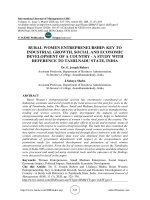Economic growth and economic development 86
Bạn đang xem bản rút gọn của tài liệu. Xem và tải ngay bản đầy đủ của tài liệu tại đây (143.87 KB, 1 trang )
Introduction to Modern Economic Growth
Theorem 2.5. Consider the following nonlinear autonomous differential equation
(2.35)
x˙ (t) = G [x (t)]
with initial value x (0), where G : Rn → Rn . Let x∗ be a steady state of this system,
i.e., G (x∗ ) = 0, and suppose that G is continuously differentiable at x∗ . Define
A ≡∇G (x∗ ) ,
and suppose that all of the eigenvalues of A have negative real parts. Then the
steady state of the differential equation (2.35) x∗ is locally asymptotically stable,
in the sense that there exists an open neighborhood of x∗ , B (x∗ ) ⊂ Rn such that
starting from any x (0) ∈ B (x∗ ), we have x (t) → x∗ .
Proof. See Luenberger (1979, Chapter 9) or Simon and Blume (1994, Chapter
25).
Ô
Once again an immediate corollary is:
Corollary 2.2. Let x (t) ∈ R, then the steady state of the linear difference
equation x˙ (t) = ax (t) is globally asymptotically stable (in the sense that x (t) → 0)
if a < 0.
Let g : R → R be continuous and differentiable at x∗ where g (x∗ ) = 0. Then,
the steady state of the nonlinear differential equation x˙ (t) = g (x (t)), x∗ , is locally
asymptotically stable if g 0 (x∗ ) < 0.
Proof. See Exercise 2.6.
Ô
Finally, with continuous time, we also have another useful theorem:
Theorem 2.6. Let g : R → R be a continuous function and suppose that there
exists a unique x∗ such that g (x∗ ) = 0. Moreover, suppose g (x) < 0 for all x >
x∗ and g (x) > 0 for all x < x∗ . Then the steady state of the nonlinear differential
equation x˙ (t) = g (x (t)), x∗ , is globally asymptotically stable, i.e., starting with any
x (0), x (t) → x∗ .
Proof. The hypotheses of the theorem imply that for all x > x∗ , x˙ < 0 and for
all x < x∗ , x˙ > 0. This establishes that x (t) → x∗ starting from any x (0) R.
72
Ô









